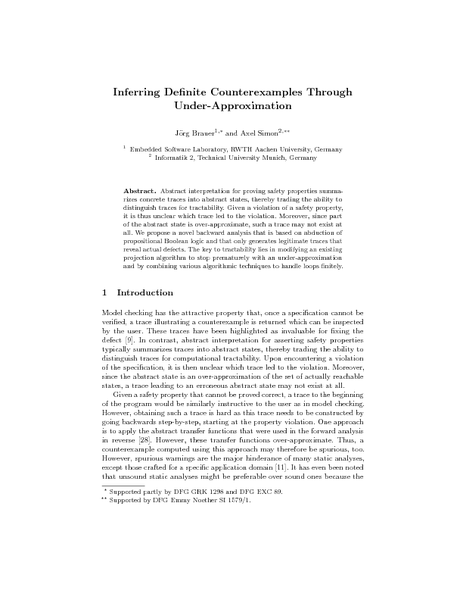Inferring Definite Counterexamples Through Under-Approximation
Abstract interpretation for proving safety properties summarizes concrete traces into abstract states, thereby trading the ability to distinguish traces for tractability. Given a violation of a safety property, it is thus unclear which trace led to the violation. Moreover, since part of the abstract state is over-approximate, such a trace may not exist at all. We propose a novel backward analysis that is based on abduction of propositional Boolean logic and that only generates legitimate traces that reveal actual defects. The key to tractability lies in modifying an existing projection algorithm to stop prematurely with an under-approximation and by combining various algorithmic techniques to handle loops finitely. 1 Introduction Model checking has the attractive property that, once a specification cannot be verified, a trace illustrating a counterexample is returned which can be inspected by the user. These traces have been highlighted as invaluable for fixing the defect [9]. In contrast, abstract interpretation for asserting safety properties typically summarizes traces into abstract states, thereby trading the ability to distinguish traces for computational tractability. Upon encountering a violation of the specification, it is then unclear which trace led to the violation. Moreover, since the abstract state is an over-approximation of the set of actually reachable states, a trace leading to an erroneous abstract state may not exist at all. Given a safety property that cannot be proved correct, a trace to the beginning of the program would be similarly instructive to the user as in model checking. However, obtaining such a trace is hard as this trace needs to be constructed by going backwards step-by-step, starting at the property violation. One approach is to apply the abstract transfer functions that were used in the forward analysis in reverse [28]. However, these transfer functions over-approximate. Thus, a counterexample computed using this approach may therefore be spurious, too. However, spurious warnings are the major hinderance of many static analyses, except those crafted for a specific application domain [11]. It has even been noted that unsound static analyses might be preferable over sound ones because the
Author
